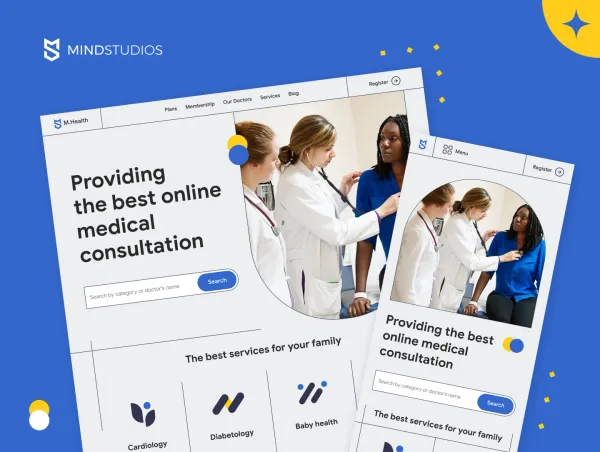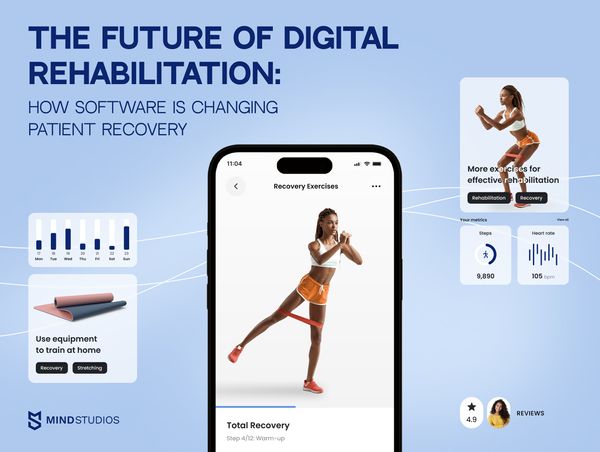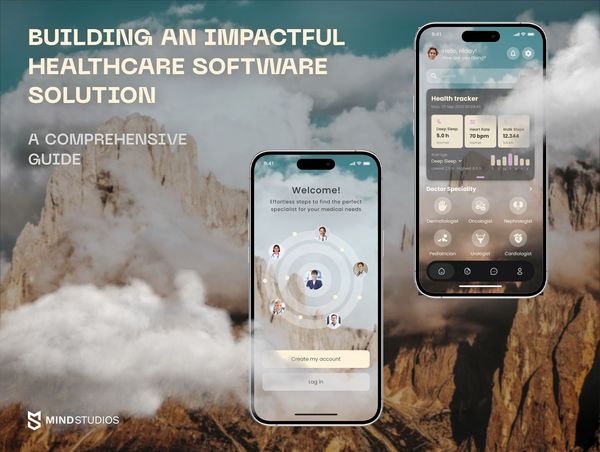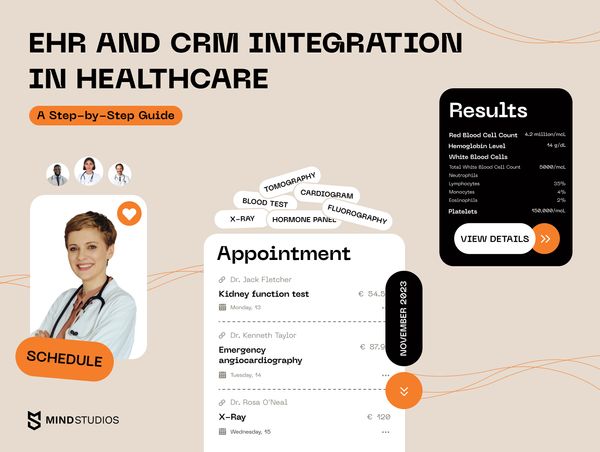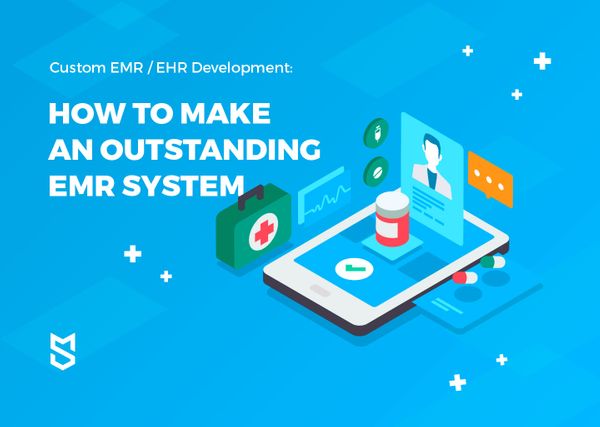
Contents:
- What is an EMR system?
- Advantages for clinics and healthcare providers
- Advantages for patients
- How can you make sure your app is HIPAA compliant?
- Must-have features of a good EMR/EHR system that save time and improve care
- How can EHR systems be improved today?
- Conduct market analysis
- Research pricing and establish the budget for your project
- Start with developing an MVP
- How much does it cost to create an online EHR/EMR system?
What is an EMR system and what tasks does it handle?
An Electronic Medical Record (EMR) system is a medical software platform that allows for the electronic recording, storage, and maintenance of information that’s typically collected in a healthcare provider’s paper charts: medical histories, diagnoses, test results, allergies, treatment contraindications, doctor’s notes, and more.
At one time, your medical data was handwritten and bound with paper forms and charts in a folder with your name on it. There was a designated order in which the medical data was structured.
The correct structure and order of medical charts was taken as a basis and interpreted to create the workflow and layout of today’s EMR and EHR systems.
But doctors have conflicting feelings about electronic health record systems.
Although they understand that they can’t provide the best possible service without online medical record systems, the majority of existing systems are rough and inconvenient to use.
In addition, user-friendly isn’t really a fitting term for the electronic medical systems that physicians use today. To see for yourself, just click this link.
A blast from the past…
To start, let’s look closely at the benefits that custom EMR/EHR systems offer patients and clinics.
Advantages for clinics and healthcare providers
- Electronic medical records are searchable and have backups on the server. This means that it’s almost impossible to lose information because it’s securely stored and can be recovered in the event of system failure.
- Electronic charts are linked to preventive care guidelines and updated as information changes.
- The occurrence of errors is low. Handwritten text can be scrawled such that prescribed medications or diagnoses are unreadable (at best) or taken for something else (at worst).
- Patient data is fully searchable and linked to patient histories.
- Patient files can be marked for drug recalls and updates.
- Patient groups can be set up and managed according to a practice’s needs.
- Charts are updated and e-filed instantly.
Advantages for patients
- Electronic medical records are available to authorized healthcare providers at any time from any location. This means that the patient’s medical team can coordinate and provide care conveniently and quickly.
- Doctor appointments can be scheduled from any computer or smartphone, and automatic appointment reminders can be sent from the EHR to the recipient.
Scheduling can be automated. Read about Doctor Appointment App Development. - All medical data including lab results, doctor’s notes, and recommendations can be tracked and reviewed at any time.
- A built-in messenger can allow patients to chat with their healthcare providers when necessary.
- Insurance cards can be scanned and instantly put into the system.
- An EHR system can automatically send bill reminders.
- Medical files are stored in secure databases where they can never be lost, misfiled, or burned in a fire.
A great custom EHR/EMR system offers a dedicated patient portal containing educational materials and a list of additional features that foster patient–physician relationships, optimize the workflow by automating manual tasks, and improve clinical outcomes. You can find more information about patient portals and their features in the next part of our article.
Read also How to Start a Telemedicine Business
What does it take to create an outstanding EMR/EHR system with rich functionality?
Let’s start with the core platform functionality and consider key points that you should keep in mind.
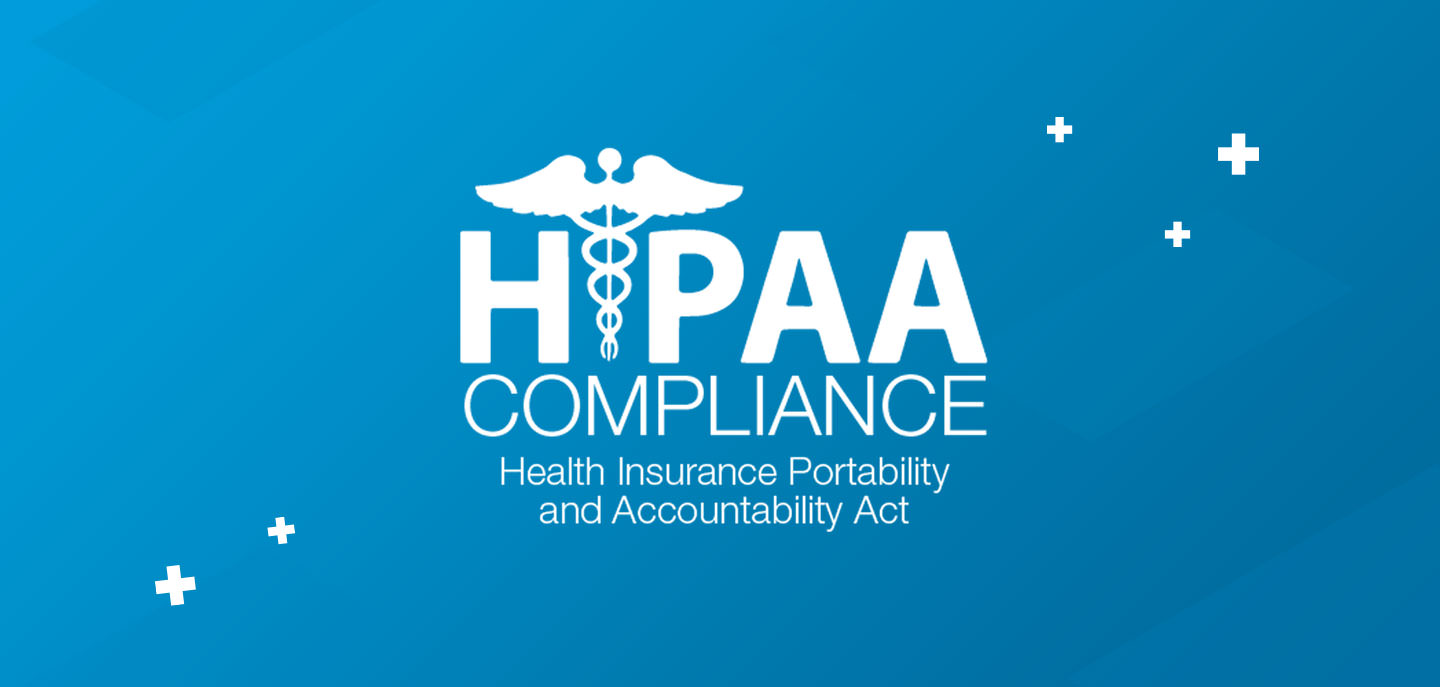
When building your own EMR/EHR software solution, keep in mind that any software product that stores or transmits protected health information has to comply with Health Insurance Portability Accountability Act (HIPAA) guidelines.
How can you make sure your app is HIPAA compliant?
HIPAA is a long summary of laws and regulations. The requirements concerning the technical side of making your own EMR system are laid down in paragraph 164.312 of the document.
The HIPAA Security Rule requires appropriate administrative, physical, and technical safeguards to ensure the confidentiality, integrity, and security of protected health information (PHI).
Disappointingly, many resources available from the US government are too outdated to be useful. However, there are two websites with relevant information:
- IPAA Developer Portal from the US Department of Health and Human Services (HHS)
- Summary of the HIPAA Security Rule from HHS
Medical software in any form that meets the imposed requirements can be called HIPAA compliant.
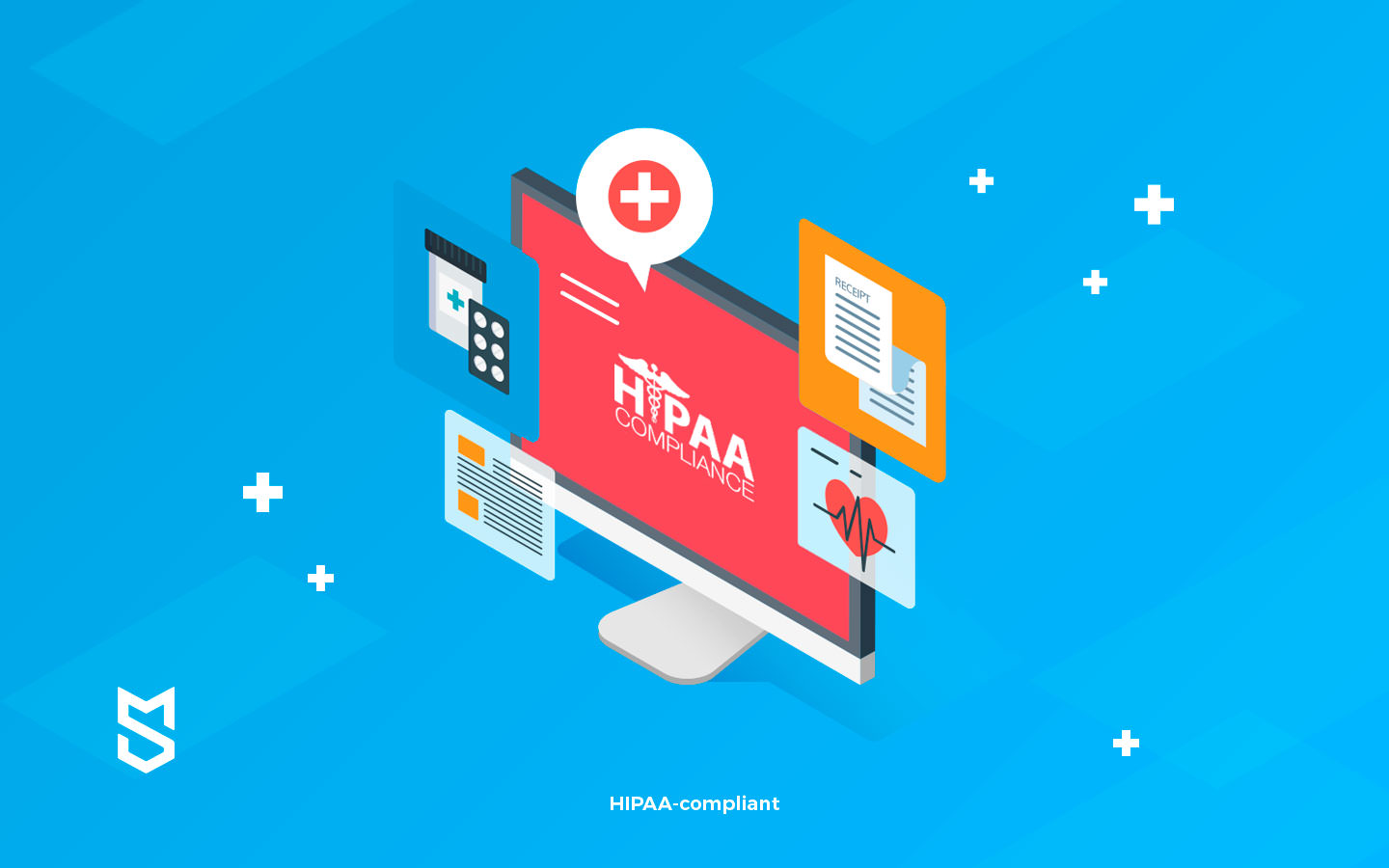
Must-have features of a good EMR/EHR system that save time and improve care
Medical centers want tailored medical record software in order to have a reporting system that will be beneficial for the facility and its staff in all spheres they cover. Custom software solutions differ from hospital to hospital, but they have common core functionality.
Let’s consider the most important aspects of an electronic medical records system for a hospital.
1. Patient page
The patient page in the EMR system contains a patient’s personal data — age, gender, address, allergies, current medications, and other information that provides an overview of the patient’s medical condition.
2. Medical history
Keeping track of a patient’s medical history — illnesses, treatments, medications, and contraindications — increases a doctor’s chances of making the right decision and diagnosing correctly on a tight schedule.
3. E-prescriptions
EMR/EHR software should be centered around patients and their treatment. Therefore, it’s crucial to implement tools for tracking prescriptions of patients, including what treatments they’re receiving now and have received in the past.
4. Charting
Filling charts is the least favorite activity among doctors all over the world.
“Doctors stay after their shifts, or chart from home, or come in on their days off in order to complete their documentation. Needless to say, this is unlikely to create the best possible chart. Not only is this true, I have watched as nurses sat for one to two hours after their busy ED shifts, catching up on the ever-increasing documentation requirements in their EMR systems.”
— Edwin Leap, MD | Physician | MARCH 9, 2015
Creating and maintaining charts in an EMR system should be hassle-free and convenient. To make charting in your product efficient, implement the following key features:
- Customizable templates
- Voice recognition
- Machine learning
Customizable templates give the possibility to adjust charts and configure them according to the needs of a practice. Voice recognition and dictation functionality can relieve stress and save time spent manually inputting information.
Machine learning will provide your custom medical records system with the ability to learn information, streamlining charting through autofilling and prompts.
5. Lab integration
To make the workflow even easier and to improve the interoperability of hospitals and labs, it’s a good idea to implement lab integration in an EMR system. This allows doctors to track the delivery of test samples and the results of tests in their software and makes reviewing results, diagnosing, and integrating data with charts fast and seamless.
6. Reminders
As it’s quite hard to remember all meetings, consultations, and other events, the best practice is to implement reminders.
Automated appointment reminders sent to patients via email or SMS will save a lot of time and reduce the number of missed appointments.
7. Patient portal
A dedicated patient portal is a real godsend for both healthcare providers and patients. And yes, the patient portal is a feature with its own features.
Companies that develop sophisticated electronic health record systems employ diverse approaches when creating and integrating patient portals that involve elaborating features and instruments that provide patients with access to the following data:
- History of visits
- Detailed hospital discharge reports
- Prescriptions
- Immunizations
- Allergies
- Lab tests with results
- Financial page with online payments, billing, and insurance information
In addition to these useful tools and data, you can enrich a web-based patient portal with convenient features such as
- a built-in secure messenger for chatting with healthcare providers;
- an appointment scheduler for easy and convenient online booking of doctors’ appointments;
- e-prescriptions for requesting and renewing prescriptions online;
- an educational forum containing a wide range of educational materials and professional tips;
- the possibility to download and fill out forms.
How can EHR systems be improved today?

Blockchain technology opens interesting and promising possibilities for storing, transferring, and managing data. The issue of data management in the healthcare industry is currently on the front burner.
Medical workers deal with a truckload of paperwork every day. And the data they manage requires maximum accuracy, anonymity, and correct circulation.
Many modern companies and developers offer blockchain-based solutions for handling huge volumes of distributed information. We’ll consider some of the most successful distributed ledger data storage systems.
Healthchain
Healthchain is a data storage system based on blockchain technology that was launched in 2017 in California by Vidushi Savant, MD.
The patient-side interface of this system displays current health information including conditions and medical recommendations.
Access to the Healthchain platform is also provided to healthcare providers, pharma companies, insurance carriers, and research organizations.
Information about patient health is represented in the form of graphs and charts.
Patients can openly access their information and get money for it from interested parties, helping professionals to improve treatment methods, attract clients, increase profits, avoid unnecessary costs, and reduce administrative overhead.
Patientory
Patientory is another data storage system developed for medical purposes. With Patientory, access to data is provided by an application. Patientory integrates with any EHR system and facilitates interactions and cooperation among healthcare providers, doctors, and patients. This platform issues its own tokens, called PTY. In exchange for PTY, users can access the network to rent storage space for medical information and make payments and transactions using smart contracts.
MedRec
MedRec is an Israeli project that is developing a blockchain system for patient medical card storage and management. Since its launch in 2016, the project has been managed by a team of Israeli researchers from MIT (the Massachusetts Institute of Technology). R&D activities of the company are supported by the MIT Media Lab and the Robert Wood Johnson Foundation.
MedRec is built on the Ethereum platform and facilitates the registration and storage of medical records in a form that allows patients, doctors, third-party healthcare providers, and even patients’ relatives to access patients’ medical records.
All data is added to the blockchain system only upon consent of the patient.
Medical records with data on diagnoses, treatments, and other medical procedures can be freely transferred from clinic to clinic. It’s assumed that computing resources for MedRec will be provided by clinics themselves. In addition, MedRec plans to conclude contracts with pharmaceutical companies for the provision of anonymous data in exchange for renting equipment. In addition to the primary task of storing distributed data, MedRec will be used for clinical and scientific research in the treatment of aging. Additionally, each patient can take advantage of open information about their own health to develop a strategy to overcome health problems.
eHealth Estonia is a consolidated project of the Estonian Electronic Health Foundation and Guardtime. The main purpose of the project is to create a single database of medical records in Estonia based on blockchain technology.
It’s noteworthy that Estonia uses the Oracle electronic database for storing patient medical records. This electronic database was implemented by Guardtime in April 2008 before the advent of Bitcoin. In 2016, the KSI Guardtime blockchain system was integrated into it.
This integration was done to ensure security in data storage, data transparency, and ease of management of the electronic system and the life cycle of medical records.
When records are modified in KSI, the system automatically creates an updated signature. This allows healthcare companies to track the illegal interventions in personal data of patients and prevent any type of fraudulent actions in the system so patients can be sure that information about their health is safe and secure.
The project has an ambitious goal to protect more than 1 million medical records.
Blockchain technology could be a catalyst that shifts American healthcare to a new level and accelerates a massive change in the way people provide and receive care, access their medical data, and live healthier.
Once you’re sure about the system and set of features you want to implement, here are the next steps you should take:
Conduct market analysis
Before plunging into your own EMR/EHR software development, it’s vital to understand the market — what great and not-so-great solutions are currently offered, what they’re good at and what they lack, what users are seeking in new systems.
As of August 2021, the list of EMR/EHR software solutions on Capterra (a service dedicated to finding and comparing software solutions) has over 500 titles. You don’t need to analyze all of them, of course. Just focus on market leaders for good pointers and maybe on failed solutions to avoid making their mistakes.
Analyzing your competitors and researching or surveying your target audience will give you a clearer picture of what your product needs to be to find its market fit.
Find out what EHR/EMR systems are widely used and popular across a given state or across the whole country. Pick up to five different platforms and start researching them.
First, read detailed user reviews weighing the pros and cons of each of the chosen systems.
Then, contact the vendors from your list and request product demos. This will allow you to explore functionality (although it might be limited) and outline the most interesting features and elements as well as highlight things that you find to need improvement.
This, in turn, will help you compile a list of features you want to implement in your own EMR system.
Read also: Healthcare App Development: Types of Medical Apps and Basic Features
Research pricing and establish the budget for your project
We always emphasize that your budget will dictate how robust, far-reaching, and sophisticated your ERM/EHR suite will be. If you can’t establish a budget or are hesitating about functionality, you can contact our team of professionals and get a free, custom quote on a complex online electronic medical records system that will fit the market and follow the healthcare technology trends.
We suggest creating a highly customizable software solution. The main purpose of a custom EMR system is to meet the requirements of the target audience or to create a system that can easily be customized based on current needs. The more narrowly focused your electronic medical records system is, the more time and mental resources it will save in the future.
Another thing you should focus on is creating a great user experience. Just recall those old-fashioned interfaces we referred to earlier.
Bad user experience is a huge problem.
The design of EMR software should be streamlined and uncomplicated yet pleasant at a glance.
In order to create a truly great product, think of hiring a team of experienced EMR software developers who know their stuff.
Start with developing an MVP

A minimum viable product (MVP) is a solution that has long since become a staple in EHR software development.
Due to the harsh competition, pouring huge amounts of money and time into full development might be risky for those new to the specific market. An MVP allows you to build an abridged product with only necessary functionality plus your unique value proposition.
Launching an MVP makes it possible to test your product before you spend all of your money on full development. MVP will provide you with:
- Initial analysis of performance
- Feedback from users
- Opportunity to catch bugs that slipped through the cracks
- Possibly your first loyal users who will stick with the app
- Possibly your first revenue stream from the app
Overall, unless you’re an established EMR/EHR service provider with a user base who will trust you from the get-go,building an MVP is a more sensible decision.
Launch your marketing campaign
Marketing is essential for any new (and not-so-new) software. To build your user base, you need to make your brand seen and recognized. The market of EMR/EHR systems is fairly unique as it targets medical service providers and not the general population. For this reason, your marketing efforts will need to be highly focused and your campaigns well-tailored.
For example, social media marketing may or may not be less effective than email inquiries or word of mouth marketing. You can also try to reach out to medical news outlets, engage in forums, or even try to get in contact with hospitals directly.
It’s recommended to have a team of professionals who will research and test marketing channels and find those that bring back the best results.
How much does it cost to create an online EHR/EMR system?
It’s difficult to estimate the minimum price of an online medical record system because of the many factors that impact the total cost.
Here are some of the factors that affect pricing.
- Complexity of the project
- Platform — iOS, Android, web
- UI/UX design — simple, average, or rich
- Features and functionality
- Integration with medical devices
- Third-party SDKs and APIs
- Compliance with Medicare and Medicaid standards
- Medical workflow automation — medication tracking, drug management, accidents and incidents, etc.
- Implementation of machine learning, AI, voice recognition and dictation, and scanning technologies
In addition, there are several other things to consider:
- Do you want an EMR system or an EMR suite? An EMR suite can involve practice management applications like billing, scheduling, and a web-based patient portal.
- Who will access the system (doctors, patients, therapists, nurse practitioners) and how many users need unique logins?
- Do you need to migrate patient data or are you new to online EHR systems?
- Do you need help setting up the system, or do you have a dedicated staff to assist with this?
Roughly speaking, the cost of tailor-made EHR software starts at $100,000 and increases depending on the set of features and functionality of the system as well as the hourly rate of the development team.
Conclusion
In our article, we’ve considered how to make your own electronic medical record system, what features to implement, and why.
EMR/EHR software development is complex and demanding. If you have a business idea but are still hesitating about it, contact a professional electronic health records development company like Mind Studios. We’ll clear things up, share our thoughts, shape up your idea, and help you create a truly outstanding online EHR system.
Are you interested in learning more about EMR software? Do you want to know the stages of EHR development? And finally, do you want to know how much it would cost to create your own custom electronic record system?
Feel free to request a quote from a team with experience in custom EMR/EHR development!

